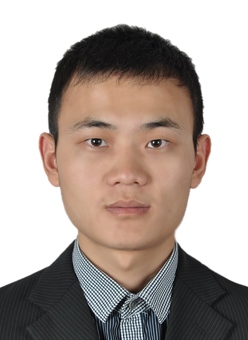|
|
Oral presentations
| Title:
Comparative transcriptome analysis of a toxin-producing dinoflagellate Alexandrium catenella and its non-toxic mutant
|
|
|

|
Mr. Yong ZHANG
State Key Laboratory of Marine Environmental Science /
College of the Environment and Ecology
Xiamen University, Xiamen, 361005, China
Abstract
The dinoflagellates and cyanobacteria are two major kingdoms of life producing paralytic shellfish toxins (PSTs), a large group of neurotoxic alkaloids causing paralytic shellfish poisonings around the world. In contrast to the well elucidated PST biosynthetic genes in cyanobacteria, little is known about the dinoflagellates. This study compared transcriptome profiles of a toxin-producing dinoflagellate, Alexandrium catenella (ACHK-T), and its non-toxic mutant form (ACHK-NT) using RNA-seq. All clean reads were assembled de novo into a total of 113,674 unigenes, and 66,812 unigenes were annotated in the known databases. Out of them, 35 genes were found to express differentially between the two strains. The up-regulated genes in ACHK-NT were involved in photosynthesis, carbon fixation and amino acid metabolism processes, indicating that more carbon and energy were utilized for cell growth. Among the down-regulated genes, expression of a unigene assigned to the long isoform of sxtA, the initiator of toxin biosynthesis in cyanobacteria, was significantly depressed, suggesting that this long transcript of sxtA might be directly involved in toxin biosynthesis and its depression resulted in the loss of the ability to synthesize PSTs in ACHK-NT. In addition, 101 putative homologs of 12 cyanobacterial sxt genes were identified, and the sxtO and sxtZ genes were identified in dinoflagellates for the first time. The findings of this study should shed light on the biosynthesis of PSTs in the dinoflagellates.
|
|
| Title:
Metaproteomics of Prorocentrum donghaiense cells collected at early and middle blooming stages from the Coastal East China Sea
|
|
|

|
Mr. Hao ZHANG
State Key Laboratory of Marine Environmental Science /
College of the Environment and Ecology
Xiamen University, Xiamen, 361005, China
Abstract
The global protein expression profiles of P. donghaiense samples collected at early and middle blooming stages were compared. The results showed that 3,300 and 4,720 proteins were confidently identified with two or more peptides in early and middle blooming samples, respectively. Taxonomic origin indicated that more than 90% of identified proteins were matched to dinoflagellates, and the proportion was higher in middle blooming sample. Proteins involved in translation, transcription, protein turnover and modification were more abundant in early blooming sample, indicating more active protein biosynthesis in early blooming sample. While proteins participating in carbohydrate, lipid, amino acid and coenzyme compound metabolic process presented higher expressions in middle blooming sample, indicating more active substance and energy metabolism to maintain rapid cell division and vigorous cell activity. More abundant urea degradating enzyme, almost all catalytic enzymes involved in urea cycle, and inorganic phosphate transport protein were identified in the blooming samples, indicating utilization of intracellular urea and high efficient transport system of inorganic phosphate in P. donghaiense, which might be an important reason resulting in the frequent occurrence of P. donghaiense in the East China Sea. Moreover, higher abundances of some cell cycle and growth regulation proteins and programmed cell death protein were detected in the middle blooming sample, revealing their importance in maintaining dinoflagellate bloom and decay processes. This study gave a snapshot of protein profiles of P. donghaiense between early and middle blooming stages, and advanced our knowledge on marine dinoflagellate bloom mechanisms.
|
|
| Title:
Changes in intracellular amino acids during a marine diatom Ditylum brightwellii resting spore formation
|
|
|

|
Mr. Lang LI
School of Life Sciences
Xiamen University
Xiamen 361102, China
Abstract
Resting spore formation is a special and important stage during the life cycle of some marine diatom species. Previous reports indicated that extracellular nitrogen (N) deficiency was an important factor controlling diatom resting spore formation. However, it is barely understood the mechanisms and the changes of intracellular N status during resting spore formation. Since the cellular pools of free amino acids (FAAs) served as a significant nitrogen buffer especially in large diatoms. These amino acids could be a sensitive indicator of the state of nitrogen nutrition. Accordingly, we used intracellular FAAs to indicate intracellular N status of Ditylum brighwellii, a centric diatom species which can form resting spore under N-limitation. Our results showed that the average content of intracellular total free amino acids (TFAAs) in D. brightwellii decreased while the percentage of resting spores increased. Compared to TFAAs at the beginning of the experiment, it decreased by 90.9% when the percentage of resting spores was up to 67.63%. It was also suggested that the intracellular N status was highly depleted in the resting spores. The resting spore formation of D. brightwellii was a process that intracellular N-limitation strengthened consistently. In addition, the ratio of glutamine (Gln) to glutamate (Glu) also showed the changes of intracellular N status during the formation of resting spores. There were mainly five kinds of intracellular FAAs involved in the formation of D. brightwellii resting spores, including glutamate (Glu), alanine (Ala), valine (Val), proline (Pro) and histidine (His). These FAAs may be associated with different metabolic mechanism, such as the regulation of C-N metabolism in the cell, the biosynthesis of thick spore wall and the changes of osmotic stress caused by N-deprivation.
|
|
| Title:
Morphological response of Skeletonema dohrnii(Bacillariophyceae) to the changes of temperature, salinity and light intensity
|
|
|

|
Ms. Yu-Han LIU
School of Life Sciences
Xiamen University
Xiamen 361102, China
Abstract
The diatom genus Skeletonema is one of the most important contributors to phytoplankton blooms which occur worldwide. The morphological characteristics of Skeletonema that belongs to a same species, such as mean number of cells per chain, chain length, cell diameter and cell height can be modified a lot in different marine habitats. According to this phenomenon, an indicator can be constructed for detecting environmental change by biological approach that differs from traditional way of using biomass or diversity. What determines chain length or number of cells per chain in a given species has not been clearly explained. However, previous observation has suggested specific factors that influence chain length of diatoms of the genus Skeletonema, which include temperature, duration of daylight, rate of cell division etc. In this study, different groups of temperature, salinity and light intensity were set for the batch culture of S. dohrnii to investigate the effect of marine environmental changes and the morphological response of S. dohrnii grown with varying factors. The results showed that the mean number of cells per chain showed no significant variation during light intensity, temperature or salinity change, while in the temperature of 10°C, there exists more chains of longer length, which could partly be explain by the existence of S. dohrnii in relatively cold waters. Also, there is a tendency of decreasing of the cell diameter and chain length with the increase of temperature and light intensity. In the salinity of 15%, all the morphological characteristics except for the mean number of cells per chain reached a peak, which could be attributed to the optimum salinity of 15% for its growing.
|
|
| Title:
Phylogenetic study of evolutionary relationships between marine Chaetoceros (Bacillariophyceae) and four inland Chaetoceros species
|
|
|

|
Ms. Jing LI
School of Life Sciences / The State Key Laboratory of Marine Environmental Science
Xiamen University, Xiamen, 361102, China
Museum of Natural History and Department of Ecology and Evolutionary Biology
University of Colorado, Boulder, Co 80309, USA
Abstract
Based on the fossil record and phylogenetic studies, diatoms are suggested to be ancestrally marine, with subsequent colonizations of freshwaters by marine species. These colonizations are considered rare, irreversible and always unidirectional, based on the idea of a salinity barrier, or ‘Rubicon’ between these types of environments. Research on the phylogenetic relationships of thalassiosiroid diatoms, however, suggests multiple exchanges between environmental types. With over 500 taxa, Chaetoceros is a large genus of diatoms, but there are no more than 20 species reported from inland habitats. To test whether or not the salinity barrier exists in Chaetoceros, four inland Chaetoceros species: C. muelleri, C. wighamii, C.cf. muelleri var. subsalsum and C. sp. were isolated and cultured from western North America. Reconstruction of the phylogeny of the four inland Chaetoceros with marine species were done by doing the Maximum Likelihood and Baysian analyses of SSU rDNA and partial LSU rDNA. The results suggest dispersal into inland systems of western North America occurred across the Chaetoceros tree of life, and that the salinity barrier was not formidable in this genus. There have been at least three independent colonizations of inland waters by marine Chaetoceros. These colonizations are not obviously related to salinity when comparing the salinity tolerance of the four inland Chaetoceros with marine species in the phylogenetic trees.
|
|
| Title:
Effect of the cell extract and different cell concentration of Karenia mikimotoi to the survival of abalone (Haliotis diversicolor)
|
|
|

|
Ms. Er-Yi XIE
School of Life Sciences
Xiamen University, Xiamen, 361005, China
Abstract
Karenia mikimotoi is one of the HAB causing organisms which can produce hemolytic toxin and harmful to aquaculture organisms and ecological system. To investigate the toxin mechanism of Karenia mikimotoi on abalone, the toxin effects of Karenia mikimotoi cell extract and different cell densities on the survival of Haliotis diversicolor were studied in laboratory. The results show that Karenia mikimotoi cell extract did not influence the survival of Haliotis diversicolor; However, the survival rate of Haliotis diversicolor decreased significantly (from 100% to 0%) with the increase of cell density of Karenia mikimotoi (from 2x106 cells/L to 8x106 cells/L), which was lower than that of the control(without Karenia mikimotoi). The half lethal concentration (LD50) of Karenia mikimotoi on Haliotis diversicolor is 4.0x106 cell/L. These results suggest that Karenia mikimotoi might pose a threat to Haliotis diversicolor, and only the living cell of Karenia mikimotoi might cause the death of Haliotis diversicolor .
|
|
| Title:
The response of photosynthetic activity during the rejuvenation of Thalassiosira pseudonana to different light intensity
|
|
|

|
Ms. Ya-Cen YU
School of Life Sciences
Xiamen University, Xiamen 361102, China
Abstract
Resting stages enable diatoms to survive under adverse conditions and serve as seed banks for subsequent bloom formation. The resting stage cells once expose to favorable environment, especially moderate illumination, they would rejuvenate and form viable cells which in turn may initiate a new bloom. Light is one of the important triggering factors for resting stages rejuvenation. After prolong darkness, T. pseudonana rejuvenated in high light conditions (100,150,200,250 µmol/m2·s), and the growth rate and relative photosynthetic activity of T. pseudonana were determined in the present study. The results showed that the cell density decreased in 48h, then increased with the rejuvenation. At 96h, the cell density was 2.2x105 cells / ml in 150 µmol/m2·s treatment, which was 45%,55%,79.5% higher than 100,200 and 250 µmol/m2·s treatments, respectively. Apparent PS? photochemical quantum efficiency (Fv/Fm) had downward trend in the first 24h. After 24h, Fv/Fm value in 150 µmol/m2·s treatment recovered quickly and it was higher than other three treatments. The values of maximum rate of electron transport and minimum saturation irradiance were highest in 150 µmol/m2·s treatment before 60h in four treatments, then it decreased significantly after 60h. Although cell density and Fv/Fm values in 150 µmol/m2·s treatments was significantly higher than other three treatments, there were no significant difference in the light-use efficiency in four treatments. Compared to vegetative cells, the growth of T. pseudonana after prolong darkness was favored by high light intensity (150 µmol/m2·s) in the present study.
|
|
| Title:
Climate change and its implication on the interdecdal variations of diatom production and species composition in a coastal marginal sea
|
|
|

|
Mr. Adilo Rediat ABATE
School of Life Sciences
Xiamen University, Xiamen 361102, China
Abstract
The implications of climate change during the second half of 21st century have been reported throughout the world. However, regardless of their rapid response to climate change relatively little attention has been given to the South East Asian marginal seas. To investigate this a sediment core was collected from Leizhou Peninsula of South China Sea (SCS) to allow study of interdecadal climate change and its consequent implication, by using the diatom valve as a proxy. Diatom absolute abundance varied from 2304 to 67788 and averaged 16099 valves per gram of dry weight (v/gdw). The total dissolution index (Fi) was usually below 0.5, which indicates a moderate preservation of diatom valves in coastal SCS. In the interdecadal time scale, relative diatom abundance was high for the period after 1960`s coinciding with 1) increased ratio of Plan:Tabn and increased Fi; 2) emerging and dominance of warm tropical and productivity indicative species that are endowed with robust frustules, Thalassionema nitzschioides and Paralia sulcata (the relative abundance of both species increased from <1.5% to >7% for the period after 1960`s); and 3) the relative abundance of small sized eutrophication indicative species, Cyclotella striata, distinctly decreased from 70% to 40%. The increased abundance of diatoms after 1960`s might not strictly indicate increased production of diatom/phytoplankton; but can be also the result of species-specific difference of diatom frustule preservations in the sediment. These results reveals that the increasing and decreasing of sediment preserved diatom abundance was a function of both production and dissolution/preservation of diatom valves, which in turn are intrinsically connected to the prevailing environmental/climatic conditions. In conclusion, all these data reveal the existence of substantial change in South China Sea in response to 1970`s regime shift that were recorded all over the world.
|
|
|

